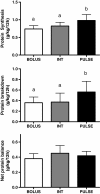Daytime pattern of post-exercise protein intake affects whole-body protein turnover in resistance-trained males
- PMID: 23067428
- PMCID: PMC3514209
- DOI: 10.1186/1743-7075-9-91
Daytime pattern of post-exercise protein intake affects whole-body protein turnover in resistance-trained males
Abstract
Background: The pattern of protein intake following exercise may impact whole-body protein turnover and net protein retention. We determined the effects of different protein feeding strategies on protein metabolism in resistance-trained young men.
Methods: Participants were randomly assigned to ingest either 80g of whey protein as 8x10g every 1.5h (PULSE; n=8), 4x20g every 3h (intermediate, INT; n=7), or 2x40g every 6h (BOLUS; n=8) after an acute bout of bilateral knee extension exercise (4x10 repetitions at 80% maximal strength). Whole-body protein turnover (Q), synthesis (S), breakdown (B), and net balance (NB) were measured throughout 12h of recovery by a bolus ingestion of [15N]glycine with urinary [15N]ammonia enrichment as the collected end-product.
Results: PULSE Q rates were greater than BOLUS (~19%, P<0.05) with a trend towards being greater than INT (~9%, P=0.08). Rates of S were 32% and 19% greater and rates of B were 51% and 57% greater for PULSE as compared to INT and BOLUS, respectively (P<0.05), with no difference between INT and BOLUS. There were no statistical differences in NB between groups (P=0.23); however, magnitude-based inferential statistics revealed likely small (mean effect±90%CI; 0.59±0.87) and moderate (0.80±0.91) increases in NB for PULSE and INT compared to BOLUS and possible small increase (0.42±1.00) for INT vs. PULSE.
Conclusion: We conclude that the pattern of ingested protein, and not only the total daily amount, can impact whole-body protein metabolism. Individuals aiming to maximize NB would likely benefit from repeated ingestion of moderate amounts of protein (~20g) at regular intervals (~3h) throughout the day.
Figures

References
-
- Protein and amino acid requirements in human nutrition. World Health Organ Tech Rep Ser. 2007. pp. 1–265. - PubMed
-
- Phillips SM, van Loon LJ. Dietary protein for athletes: From requirements to optimum adaptation. J Sports Sci. 2011;29(Suppl 1):S29–S38. - PubMed
-
- Barja I, Araya H, Munoz P, Vega L, Arteaga A, Tagle MA. Effect of spacing protein intake on nitrogen balance in normal children. Am J Clin Nutr. 1972;25:506–511. - PubMed
-
- Leverton RM, Gram MR. Nitrogen excretion of women related to the distribution of animal protein in daily meals. J Nutr. 1949;39:57–65. - PubMed
LinkOut - more resources
Full Text Sources

